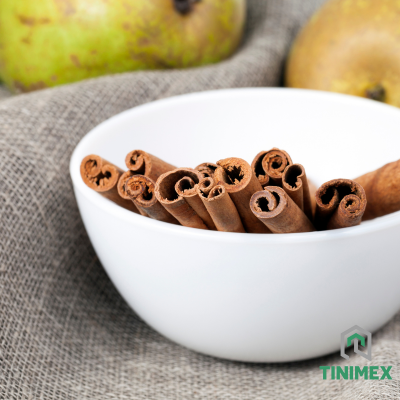5 Types of Cinnamon: Exploring Their Wonderful Characteristics and the Different Varieties
Cinnamon is a beloved spice that has been cherished for centuries for its aromatic fragrance and versatile flavor. Derived from the inner bark of several tree species belonging to the genus Cinnamomum, cinnamon is used worldwide in both culinary and medicinal applications. The distinct flavor and aroma of cinnamon come from its essential oils, primarily cinnamaldehyde, which gives it its characteristic warmth and spiciness. Exploring the different varieties of cinnamon allows you to experience the diversity of flavors and aromas that this beloved spice has to offer. So why not embark on a culinary adventure and discover the world of cinnamon beyond the familiar varieties. You may be surprised by the unique qualities that await you!
1.Ceylon Cinnamon (Cinnamomum verum):
Originating from Sri Lanka and southern parts of India, Ceylon cinnamon, also referred to as “true cinnamon,” holds a distinguished place in the world of spices. Its delicate and subtle flavor profile with citrusy undertones sets it apart from other cinnamon varieties. Ceylon cinnamon is renowned for its lighter color and softer texture, making it a preferred choice for culinary applications where a mild sweetness is desired. In addition to its culinary uses, Ceylon cinnamon has a rich history rooted in traditional medicine, where it has been utilized for its potential health benefits. The cultivation and harvesting of Ceylon cinnamon involve traditional methods passed down through generations, reflecting the cultural heritage and expertise of the local communities
2.Cassia Cinnamon (Cinnamomum cassia):
Originating from China and cultivated in various parts of Southeast Asia, Cassia cinnamon is recognized for its robust and intense flavor profile. Unlike Ceylon cinnamon, Cassia cinnamon has a darker color and a thicker bark with a rougher texture. Its bold flavor makes it a popular choice for baking applications, where its pronounced cinnamon notes add depth and warmth to a wide range of recipes. In addition to its culinary uses, Cassia cinnamon is valued in traditional Chinese medicine for its purported health benefits, including anti-inflammatory and antimicrobial properties. The cultivation of Cassia cinnamon involves specific growing conditions and harvesting techniques tailored to optimize its flavor and aroma.
3.Saigon Cinnamon (Cinnamomum loureiroi):
Saigon cinnamon, also known as Vietnamese cinnamon, is primarily cultivated in Vietnam and is renowned for its intense and spicy flavor profile. With a reddish-brown color and a smooth, flaky texture, Saigon cinnamon adds a bold and assertive cinnamon flavor to dishes. It is commonly used in Vietnamese cuisine, particularly in savory dishes such as curries, stews, and meat marinades. Saigon cinnamon’s robust flavor also makes it a popular choice for spiced beverages and desserts that require a kick of cinnamon warmth. The cultivation of Saigon cinnamon involves meticulous attention to soil quality, climate conditions, and harvesting methods to ensure optimal flavor development.
 4.Indonesian Cinnamon (Cinnamomum burmannii):
4.Indonesian Cinnamon (Cinnamomum burmannii):
Also known as cassia cinnamon, Chinese cinnamon is primarily cultivated in China and is widely utilized in Chinese cooking. With a strong and pungent flavor accompanied by a rich, woody aroma, Chinese cinnamon adds depth and complexity to dishes. Its dark brown color and thick bark with deep ridges distinguish it from other cinnamon varieties. Chinese cinnamon is commonly used in Chinese cuisine to flavor meats, soups, and stir-fries, as well as in baking applications that require a bold cinnamon presence. The cultivation of Chinese cinnamon involves specific growing conditions and harvesting techniques to preserve its distinctive flavor and aroma characteristics.
5.Chinese Cinnamon (Cinnamomum aromaticum):
Also known as cassia cinnamon, Chinese cinnamon is primarily cultivated in China and is widely utilized in Chinese cooking. With a strong and pungent flavor accompanied by a rich, woody aroma, Chinese cinnamon adds depth and complexity to dishes. Its dark brown color and thick bark with deep ridges distinguish it from other cinnamon varieties. Chinese cinnamon is commonly used in Chinese cuisine to flavor meats, soups, and stir-fries, as well as in baking applications that require a bold cinnamon presence. The cultivation of Chinese cinnamon involves specific growing conditions and harvesting techniques to preserve its distinctive flavor and aroma characteristics.
Conclusion: Each type of cinnamon offers its own unique flavor profile and culinary uses, allowing chefs and home cooks to experiment with different varieties to enhance their dishes. Whether you prefer the delicate sweetness of Ceylon cinnamon or the bold spiciness of Saigon cinnamon, there’s a type of cinnamon to suit every palate and recipe. So why not explore the world of cinnamon and discover your favorite variety today?
* Our company:
Location: No.40 Ngo Gia Tu Str., Duc Giang Ward, Long Bien Dist, Ha Noi City, Vietnam
Contact: +84 366 808 683
Email: info@tinimex.com
Website: www.tinimex.com
* Our factory:
+ Yen Bai factory: Mau A Town, Văn Yen Dist., Yen Bai Province, Vietnam
+ Ben Tre Factory: Hamlet 2, Son Phu Commune, Giong Trom District, Ben Tre Province
+ Lang Son Factory: Dong Dang town, Cao Loc, Lang Son Province, Vietnam
All our Factories strictly control the system by ISO 22000:2018, HACCP, FDA.
*Our products:

